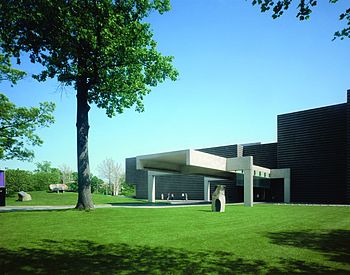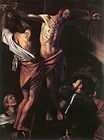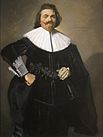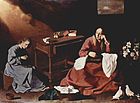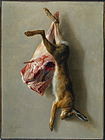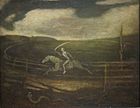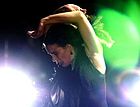- Cleveland Museum of Art
-
The Cleveland Museum of Art 
Established 1913 (Officially opened in 1916) Location 11150 East Boulevard
Cleveland, Ohio 44106
USADirector David Franklin President Earl Wolfgang Website www.clevelandart.org The Cleveland Museum of Art (CMA) is an art museum situated in the Wade Park District, in the University Circle neighborhood on Cleveland's east side. Internationally renowned for its substantial holdings of Asian and Egyptian art, the museum houses a diverse permanent collection of more than 43,000 works of art from around the world.[1][2] The Cleveland Museum of Art has remained historically true to the vision of its founders, keeping general admission free to the public.[3]
Contents
History
Beginnings
"For the benefit of all people, forever."[4]
The Cleveland Museum of Art was founded as a trust in 1913 with an endowment from prominent Cleveland industrialists Hinman Hurlbut, John Huntington and Horace Kelley.[5] The neoclassical, white Georgian Marble, Beaux-Arts building was constructed on the southern edge of Wade Park, at the cost of $1.25 million.[6] Wade Park and the museum were designed by the local architectural firm, Hubbell & Benes, with the museum planned as the park's centerpiece.[7] The 75-acre (300,000 m2) green space takes its name from philanthropist Jeptha H. Wade, who donated part of his wooded estate to the city in 1881.[8] The museum opened its doors to the public on June 6, 1916, with Wade's grandson, Jeptha H. Wade II, proclaiming it, 'for the benefit of all people, forever.' Wade, like his grandfather, had a great interest in art and served as the museum's first vice-president, and later as president in 1920.[9] Today, the park, with the museum still its centerpiece, is on the National Register of Historic Places.[10]
Mid to Late 20th Century Expansion
In March 1958, the first addition to the building opened, doubling the museum's floorspace. In 1971 the museum again expanded with the opening of the North Wing. With its stepped, two-toned granite facade, the addition designed by the Hungarian-born modernist architect Marcel Breuer, provided angular lines in distinct contrast with the flourishes of the 1916 building's neoclassical facade. In 1983, a third addition was made to house the museum's now expansive library, as well as to provide sufficient space for nine new galleries. Both the 1958 and 1983 additions, however, would be demolished to make way for the museum's largest expansion to date, a glass and steel structure designed by award-winning Uruguyan architect, Rafael Viñoly.
Expansion in the 21st Century
The Cleveland Museum of Art, "Building for the Future"
The museum's building and renovation project, "Building for the Future",[4] began in 2005 and was originally targeted for completion in 2012 (now 2013). The $350 million project—two-thirds of which is earmarked for the complete renovation of the original structure—will add two new wings, and is the largest cultural project in Ohio's history.[4] The new east and west wings, as well as the enclosing of the atrium courtyard under a soaring glass canopy, will bring the museum's total floor space to 592,000 square feet (55,000 m2) (an increase of approximately 65%).
While the first phase of the project cost saw $9.3 million in cost overruns and pushed back the initial reopening by 9 months, (then) museum director Timothy Rub assured the public that increase in quality would be worth both the wait and expense.[11]
In June 2008, after being closed for nearly three years for the overhaul, the museum reopened 19 of its permanent galleries to the public in the renovated 1916 building main floor.
On June 27, 2009, the newly constructed East Wing (which contains the Impressionist, Contemporary, and Modern art collections) opened to the public.
On June 26, 2010, the ground level of the 1916 building reopened and now houses the collections of Greek, Roman, Egyptian, Sub-Saharan African, Byzantine, and Medieval art.[12]
When completed, the expanded museum will include enhanced visitor amenities consisting of new restrooms, an expanded store and café, parking capacity increased to 620 spaces, and a 34,000 square feet (3,200 m2) glass-covered courtyard.
In 2010, the Museum announced the appointment of a new director, David Franklin, formerly deputy director of the National Gallery of Canada.[13]
The Museum has a $600 million endowment, making it "one of the wealthiest in the nation."[13]
Wade Park
Main article: Wade Park (Cleveland park)The park also provides an outdoor gallery, with part of the museum's holdings being showcased in the Wade Park Fine Arts Garden. The bulk of this collection are located between the original 1916 main entrance to the building and the lagoon. Highlights of this sizable collection of public sculpture include the large cast of Rodin's The Thinker, which sits atop of the museums main staircase. The statue has a unique but troubled history. Partially destroyed in a 1970 bombing (allegedly by The Weathermen),[14] the statue has been left in its unrestored condition. The reasoning for not repairing it stems from the close involvement of Rodin in its original casting. Today, the damage—which is notated on the plaque mounted at the base of the statue's pedestal—has come to define the casting as unique among the more than twenty original large castings.
Other prominent sculptures in the garden include Chester Beach's 1927 Fountain of the Waters; a monument to the Polish expatriate and American Revolutionary War-hero Tadeusz Kościuszko; and the 1928 bronze statuary sundial by Frank Jirouch, Night Passing the Earth to Day, which sits across Wade Lagoon from the museum, near the park's entrance on Euclid Avenue.
Holdings
 Pablo Picasso's, Blue Period piece, La Vie (1903), is one of the highlights of the museum's Modern European Painting and Sculpture collection.
Pablo Picasso's, Blue Period piece, La Vie (1903), is one of the highlights of the museum's Modern European Painting and Sculpture collection.
Permanent gallery collection
The Cleveland Museum of Art divides its collections into 15 departments including Chinese Art, Modern European Art, African Art, Drawings, Prints, European Painting & Sculpture, Textiles & Islamic Art, American Painting & Sculpture, Greek & Roman Art, Contemporary Art, Medieval Art, Decorative Art & Design, Art of the Ancient Americas and Oceania, Photography and Contemporary Art. Artists represented by significant works include Botticelli, Caravaggio, El Greco, Poussin, Rubens, Frans Hals, Gerard David, Goya, J.M.W. Turner, Dalí, Matisse, Renoir, Gauguin, Church, Cole, Corot, Eakins, Monet, van Gogh, Picasso, Bellows. The Museum has been active recently in acquiring later 20th-century art, having added important works by Warhol, Pollock, Christo, Kiefer, Richter, Clemente, Kossoff, Close, Mangold, Tansey and LeWitt, among others.
The museum also maintains a schedule of special exhibitions, lectures, films and musical programs. The department of performing arts, music and film hosts a film series[15] and the VIVA! & Gala[16] concert series, which brings creative energies of internationally renowned artists into Cleveland.
The department of education at CMA creates programs for lifelong learning from lectures, talks and studio classes to outreach programs and community events, such as Parade the Circle",[17] Chalk Festival[18] and the "Winter Lights Lantern Festival".[19] Educational programs include distance learning,[20] "Art to Go",[21] and the "Educator's Academy".[22] The museum is also home to the Ingalls Library, one of the largest art museum libraries in the United States with almost 431,000 volumes.[23]
Ingalls Library
In addition to its comprehensive collection of fine art, the Cleveland Museum of Art is also home to the Ingalls Library, one of the largest art libraries in the United States.[23] As part of the initial 1913 plan by the museum's founders, a library of 10,000 volumes was to be assembled, to include photographs and archival works. By the 1950s, the collection of books alone had surpassed 37,000 and the photographic collection neared 47,000.[24] Today, with more than 431,000 volumes (and 500,000 digitized slides), renovation of the library space was one of the focal points in the museum's $350 million dollar expansion.
Collection highlights
In June 2004, the museum acquired an ancient bronze sculpture of Apollo Sauroktonos, believed to be an original work by Praxiteles of Athens. Because the work has a contested provenance, the museum continues to study the dating and attribution of the sculpture. In 2011, Michael Bennet, the Greek and Roman arts curator, announced that he had dated the piece to 350 B.C. to 250 B.C.[25]
The museum is especially strong in the field of Asian art, possessing one of the best collections in the U.S.[26]
In 2008, the United States Postal Service selected the Cleveland Museum's famed Botticelli painting entitled, Virgin and Child with the Young John the Baptist, as the Christmas stamp for that year.[27]
-
Frans Hals Portrait of Tieleman Roosterman, 1634.
-
Nicolas Poussin, Holy Family on the Steps, 1648.
-
Jean-Baptiste Oudry, A Hare and a Leg of Lamb, 1742.
-
William Sidney Mount, The Power of Music, 1847.
-
Frederic Edwin Church, Twilight in the Wilderness, 1860.
-
Berthe Morisot, Reading, 1873
-
Claude Monet, The Red Kerchief: Portrait of Mrs. Monet, 1868-1878.
-
Auguste Rodin, The Thinker, 1880-1881 (showing damage from the 1970 pipe bomb).
-
Edgar Degas, Freize of Dancers, 1895.
-
Albert Pinkham Ryder, The Race Track (Death on a Pale Horse), 1896-1908.
-
Henri Rousseau, Fight Between a Tiger and a Buffalo, 1908
-
Walker Evans, Allie Mae Burroughs, Wife of a Cotton Sharecropper, Hale County, Alabama, 1936.
Festivals
The museum has also take an active role in presenting music concerts and lectures. These include performances by the Cavani Quartet, Alisa Weilerstein, and commissions for new works of Philadelphia composer Joseph Hallman among others.
-
Noche Flamenca, part of CMA's VIVA! & Gala.[28]
References
- ^ DIA's collection has national luster | detnews.com | The Detroit News - 11/06/2007
- ^ Cleveland Museum of Art - Online Collections
- ^ http://clevelandart.wordpress.com/about/
- ^ a b c http://www.clevelandart.org/about/the%20building%20project.aspx
- ^ http://www.clevelandart.org/
- ^ http://www.clevelandart.org/about.aspx
- ^ http://www.architectureofcleveland.com/html/hubbell.html
- ^ http://ech.case.edu/ech-cgi/article.pl?id=WJHI
- ^ http://ech.cwru.edu/ech-cgi/article.pl?id=WJHI1
- ^ http://www.nationalregisterofhistoricplaces.com/oh/Cuyahoga/districts.html
- ^ Cleveland Museum of Art renovations beginning to see the light, The Plain Dealer, March 29, 2008.
- ^ http://www.clevelandart.org/calendar.aspx
- ^ a b "David Franklin of the National Gallery of Canada named director of the Cleveland Museum of Art," Steven Litt, August 27, 2010, Plain Dealer.
- ^ JAIC 1998, Volume 37, Number 2, Article 2 (pp. 173 to 186)
- ^ http://www.clevelandart.org/events/films.aspx
- ^ The Cleveland Museum of Art: VIVA! & Gala
- ^ http://www.clevelandart.org/events/art%20festivals/Parade%20Workshops.aspx/uid/%7B110D559F-DEA5-42EA-9C1C-8A5DF7E70EF9%7D/ispopup/1
- ^ CMA Community Arts Festivals : Index
- ^ CMA Community Arts Festivals : 2008 Winter Lights Lantern Festival and Holiday CircleFest
- ^ The Cleveland Museum of Art Distance Learning
- ^ The Cleveland Museum of Art Art to Go
- ^ Cleveland Museum of Art - Educators Academy
- ^ a b Cleveland Museum of Art - Library and Research
- ^ http://www.clevelandart.org/Ingalls%20Library%20and%20Archives/about%20us.aspx
- ^ http://www.clevelandart.org/collections.aspx Cleveland Art Apollo
- ^ DIA's collection has national luster | detnews.com | The Detroit News - 11/06/2007
- ^ http://www.usps.com/communications/newsroom/localnews/in/in_2008_1024.htm
- ^ CMA Research Resources : The Thinker at the CMA
External links
- Official site
- FRAME - The Cleveland Museum of Art is a member of FRAME (French Regional American Museum Exchange) and has presented and contributed to FRAME-sponsored exhibitions.
Coordinates: 41°30′32″N 81°36′42″W / 41.50889°N 81.61167°W
Categories:- Beaux-Arts buildings
- Museums in Cleveland, Ohio
- Art museums in Ohio
- University Circle
- Marcel Breuer buildings
- Rafael Viñoly buildings
- FRAME Museums
- Institutions accredited by the American Association of Museums
Wikimedia Foundation. 2010.


